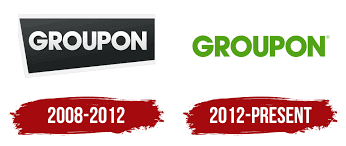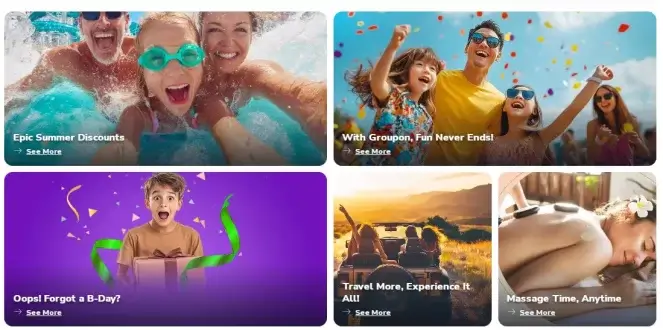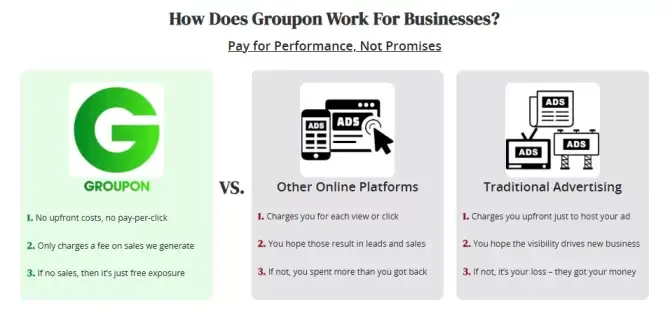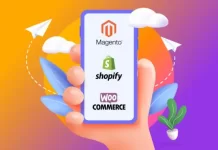Have you ever scrolled through your phone and seen one of those “80% off spa day” deals and thought… wait, what’s the catch? That’s probably Groupon doing its thing. It’s one of those platforms that’s been around for a while, quietly serving up deals on everything from sushi nights to skydiving lessons. But if you’ve ever paused and thought, okay, but how does this even work? Yeah, you’re not the only one.
Groupon isn’t just another coupon site. It kind of changed the game when it launched, blending discounts with local discovery. It helped people try new things without paying full price, and at the same time, it gave small businesses a shot at pulling in fresh customers.
This article is going to walk you through what is Groupon, how it works (both for you and the businesses behind the scenes), and why it still matters, even with a million discount apps out there now.
What is Groupon?
So, at its core, Groupon is a platform that helps you find local deals like legit discounts on restaurants, activities, products, services… all the fun (and useful) stuff. The name itself is a mashup of “group” and “coupon,” which kind of gives away its original concept: deals that only unlock when a certain number of people jump in.
When it first launched back in 2008, Groupon was all about that group-buying vibe. The idea was simple: get enough people interested in a deal, and boom, everyone gets a discount. Businesses liked it because it brought in foot traffic. Customers loved it because, well, who doesn’t like paying less?
But over the years, the model evolved. Groupon ditched the whole “group minimum” thing and started offering deals that were instantly available. No waiting, no thresholds. Just find something cool, grab the offer, and you’re good to go.
Today, it’s more like a digital marketplace for discounts. You scroll through, find a deal near you (or online), and redeem it through their site or app. That’s pretty much the gist of it, but there’s a little more under the hood, and we’ll get into that in the next section.

A Brief History of Groupon
Groupon kicked things off in 2008, right out of Chicago. It started as this experimental idea under a project called The Point, which was all about collective action, people coming together to make things happen. That idea morphed into Groupon, where instead of donating or campaigning, the “collective action” was getting a deal unlocked if enough people were interested.
And honestly? It took off like wildfire. Daily deals were the thing. Businesses loved the exposure, and customers were getting 50%, 60%, and even 90% off local experiences they might not have tried otherwise. Restaurants, spas, comedy shows, yoga classes you name it, Groupon had it.
By 2010, it was in dozens of countries and rejecting buyout offers from, get this, Google. Everyone wanted in on the daily deal gold rush. But here’s where it gets interesting: that hype didn’t last forever. People started feeling deal fatigue. Merchants complained about low profits or one-time customers who never came back.
So Groupon had to pivot. Instead of waiting for deals to “tip” or hit a group minimum, they made offers instantly available. No waiting around. It shifted from this buzzy group-buying gimmick to more of a discount marketplace. And while it’s not in the spotlight the way it once was, it’s still hanging in there and evolving.
From Group Buying to Instant Deals
In the beginning, Groupon was all about the crowd. You’d find a cool deal say, 70% off a sushi dinner but it wouldn’t actually activate unless a certain number of people bought in. That was the hook: strength in numbers. It created this kind of urgency and community buzz, like, “Hey, let’s all jump on this so we can unlock the deal.”
But as fun as that sounded, it had its flaws. Sometimes deals didn’t “tip,” and people would be left hanging. Plus, waiting around for others to join? Yeah… not exactly the instant gratification we’re used to now.
So Groupon did what most smart platforms eventually do it adapted. They scrapped the group minimum and made deals available immediately. No thresholds, no waiting. If you liked it, you bought it. Done.
This shift opened the doors for more casual users and impulse buyers. It also helped businesses get faster traction without relying on a certain number of people to make the campaign worthwhile. The whole platform became faster, simpler, and honestly, more in line with how we shop today on the go, in the moment, and expecting quick results.
What You Can Find on Groupon
Groupon’s kind of like a digital treasure hunt. You pop in to look for a simple dinner deal and suddenly you’re staring at a half-off ziplining adventure or a discount on laser hair removal. It covers a lot of ground.
At its core, Groupon is split into a few main categories: local services, travel, products, and events. Local stuff is where most people start. We’re talking massages, haircuts, oil changes, dental cleanings, pretty much anything you can book in your city at a discount. Some places even throw in a freebie just to get you through the door.
Then there’s Groupon Getaways, which is all about travel deals. Weekend trips, hotel stays, resort packages, some of them are surprisingly good if your timing’s right. It’s not your big-name travel site, but it’s a solid place to find affordable mini-vacations.
Shopping on Groupon? Yep, that’s a thing too. You’ll find everything from quirky gadgets and home goods to fitness gear and electronics. Think of it like a clearance aisle that updates daily.
And let’s not forget events and experiences. Comedy nights, paint-and-sip classes, escape rooms, and tickets to shows it’s a fun way to try something new without spending a fortune. Honestly, half the fun of Groupon is just scrolling through the randomness and thinking, “Huh, I didn’t know I wanted to try axe throwing, but now I kinda do.”
So yeah, there’s a little bit of everything. Whether you’re looking for something practical or spontaneous, Groupon probably has a deal for it.
Groupon as a Marketplace, Not Just a Coupon Site
A lot of people still think Groupon is just about coupons like, you grab a code, flash it at a cashier, and that’s the end of the story. But it’s moved way beyond that. These days, Groupon works more like a full-blown marketplace.
You’ve got user accounts, saved favorites, email alerts, and purchase history. It’s not just browsing and buying, it’s more like curating your little discount wishlist. You can follow certain types of deals, get notified when new offers pop up in your area and leave reviews after you try something.
On the business side, it’s not just “post a deal and wait.” Merchants have their own listings sort of like a storefront inside Groupon. They can add descriptions, upload photos, manage availability, and respond to customer feedback. It’s more hands-on than people expect.
And yeah, there are ratings and reviews now too, just like you’d see on Yelp or Google. So if a spa has thousands of positive reviews, that adds some real trust. And if a restaurant has two stars and a string of angry comments about cold food… well, maybe skip that one.
Bottom line: Groupon’s not just dishing out one-off discounts anymore. It’s evolved into a platform where users can explore, book, and rate experiences all without leaving the app or site. It’s more structured, more interactive, and a whole lot closer to a marketplace than just a coupon site.
To dive deeper into how platforms like Groupon operate, check out our detailed guide on the marketplace business model.
Key Features of Groupon
Groupon isn’t just about random discounts but it’s built around a few features that make the whole experience feel kind of fun and (sometimes) even addictive. Whether you’re hunting for a spontaneous massage deal or trying to save on everyday stuff, these features are what keep users coming back. It’s quick, it’s local, and it’s all laid out in a way that makes scrolling feel like a mini shopping adventure.
Daily Deals
This is the heartbeat of Groupon. The site thrives on time-sensitive offers those “act fast” kind of deals that are here today, gone tomorrow. You log in, and boom, new stuff every day. It might be half-off sushi, a discount on car detailing, or a yoga class for the price of a coffee. The urgency adds a little thrill. And for the deal-hungry crowd? It’s a daily scroll ritual.
Categories
To keep things from turning into complete chaos, Groupon organizes everything into categories. It’s not perfect, but it helps you zero in on what you want, whether that’s something in your area or a product you didn’t even know you needed.
Local
This is where most people spend their time. It includes all the stuff happening around you restaurants, spas, gyms, events, classes, car washes, everything, you name it. If it’s nearby and willing to offer a discount, it’s probably here.
Travel
If you’ve ever dreamed of a spontaneous weekend getaway, Groupon’s got a tab for that. Hotels, vacation packages, cruises, and even international trips show up here. Sure, you’ve gotta read the fine print, but the prices? Kinda tempting.
Goods
You can shop on Groupon, yep, like a regular e-commerce site. Weird little gadgets, home decor, fitness gear, electronics, it’s all there. The selection is hit or miss, but every once in a while, you’ll stumble on something you didn’t know you wanted.
Services
These are the “life admin” deals, think dental cleanings, oil changes, pest control, or even resume writing. A lot of businesses use Groupon to bring in first-time customers, so you’ll often find solid discounts for trying something new.
Mobile App and Location-Based Offers
The Groupon app makes deal-hunting feel way more personal. As soon as you open it, it pulls up offers based on where you are. So if you’re out and about and want a quick bite or a last-minute massage nearby, the app’s got you. You can buy, book, and redeem everything straight from your phone, no printing, and no awkward emails, just show the voucher at the counter and you’re good.
Benefits of Using Groupon
Groupon isn’t just about catching a random deal here and there. It’s built in a way that creates value for both the people using it and the businesses offering the deals. Whether you’re a customer looking to try something new without spending a fortune, or a small business trying to get noticed, Groupon opens up some interesting opportunities. Let’s break down the benefits from both sides.
For Consumers
From casual shoppers to curious explorers, consumers are at the heart of Groupon. And honestly, it’s more than just saving a few bucks, there’s a real experience factor built into the platform.
Affordable Access to Premium Services
One of the biggest perks for users? Getting to try things they wouldn’t normally splurge on. We’re talking luxury spa treatments, high-end salon services, gourmet tasting menus, private yoga classes, the kind of stuff that usually comes with a pretty steep price tag. Groupon knocks those prices down, sometimes by 50% or more, which makes it way more approachable.
So if you’ve always wanted to try microblading or a couples massage but couldn’t justify the full cost, Groupon gives you a low-risk way to dip your toes in. You still get the same experience, just without the credit card regret.
Easy Way to Discover Local Businesses
It’s also a great tool for discovering new spots in your area. Maybe you’ve walked past a restaurant or spa a hundred times and never stepped inside. But then you see it on Groupon with a sweet deal, and suddenly you’re booking it. It lowers the barrier to trying something new.
And that discovery factor matters. A lot of users end up finding their go-to nail salon or dentist or weekend brunch place through Groupon. It’s kind of like a local guide, except everything comes with a discount.
For Businesses
From a business perspective, Groupon can be a mixed bag, but when it’s used strategically, it can bring in big value. Especially for newer businesses trying to get their name out there, or established ones looking to fill slow days.
Exposure to a Wider Audience
Let’s face it getting noticed is tough. Local advertising is expensive, social media reach is inconsistent, and word of mouth takes time. Groupon gives businesses instant visibility to a massive, deal-hunting audience that’s actively looking for offers in their area.
And this isn’t passive reach. These are people ready to try something new. So instead of spending money on ads that may or may not convert, Groupon offers a way to get paying customers through the door even if it’s at a discount.
Marketing Boost and Potential Customer Loyalty
Think of Groupon as a marketing platform in disguise. It’s not just about the one-time sale. If a customer has a great experience, there’s a real chance they’ll come back even without a deal next time. That’s where the long-term value is.
Plenty of businesses use Groupon to build initial traction, collect reviews, and create buzz. It can even help them build an email list or gain more followers if the offer includes something like a loyalty perk or a future discount. The trick is delivering a solid experience so that the customer remembers the brand not just the discount.
Who Uses Groupon and Why?
Not everyone’s hunting down daily deals or obsessively checking for half-price sushi, but there’s a clear pattern to who gravitates toward Groupon and why. Over the years, Groupon’s user base has become surprisingly diverse, but there are still some common threads when you look at the data and behavior. Let’s break it down.
Demographics of Users
Groupon originally caught fire with young professionals looking for fun things to do without spending a fortune. That crowd still makes up a solid chunk of the user base, especially millennials in urban and suburban areas who are constantly on the lookout for value and variety.
You’ll also find plenty of students and budget-conscious families using the platform. For college kids, it’s a go-to for cheap eats, fitness classes, or quirky weekend plans. For parents, it’s a way to keep things affordable, whether that’s discounted zoo tickets or a break on auto maintenance.
Interestingly, there’s also a growing number of older users i.e., folks in their 40s and 50s, who are now comfortable shopping online and appreciate a good deal on things like wellness services, travel, or home repairs.
It’s not limited to any one group. What ties most Groupon users together is less about age or location and more about mindset they’re deal-driven, experience-hungry, and open to discovering new things.
Motivations and Purchasing Behavior
People don’t use Groupon just to save money, though yes, that’s part of it. A lot of users are in it for the experience. It’s a low-risk way to try something new, whether that’s float therapy, glass-blowing classes, or just a new restaurant down the block. The discount makes it easier to justify stepping out of your comfort zone.
There’s also the “treat yourself” mindset. Groupon permits people to indulge a little, get that facial, book the wine tasting, and plan a quick weekend getaway because it’s on sale. It feels more justifiable when it’s discounted, even if it’s still technically a splurge.
And don’t underestimate the thrill of the hunt. There’s something satisfying about scrolling through and snagging a limited-time deal. It creates a little urgency, a little excitement like scoring something exclusive, even if a thousand other people are doing the same.
So, whether it’s about saving money, trying something new, or just chasing that little dopamine hit from grabbing a good deal, Groupon taps into a lot of motivations. And that’s a big part of why it works.
Types of Deals You’ll Find on Groupon

Groupon isn’t just throwing out random discounts it’s pretty strategic about the kinds of offers it runs. Some are based on time, others on location, and a bunch ties into holidays or events. If you’ve ever wondered why that facial deal disappeared in two hours or why your app suddenly looks like a Valentine’s Day gift guide, it’s all part of the game. Here’s how the different types of deals work.
Flash Sales
These are the blink-and-you-miss-it kind of deals. Flash sales usually pop up unannounced and stick around for just a short window sometimes just a few hours. The goal? To create urgency. You’ll see big discounts, limited quantities, and a timer counting down, which adds just enough pressure to get people to hit that “buy” button before thinking too hard.
They’re great for last-minute bookings or impulse buys. It might be a surprise spa discount or half-off at a local burger joint, either way, flash sales are designed to move fast and reward quick decisions.
Limited-Time and Location-Based Offers
Groupon’s also big on tailoring deals to where you are and what’s happening around you. The app uses your location to serve up nearby offers so if you’re in downtown Mumbai or central Chicago, you’re not going to see the same deals as someone in the suburbs.
These offers usually come with a time limit, too. You might get a week to book that haircut deal, or two days to claim discounted movie tickets in your area. It keeps the inventory fresh and localized, so you’re always seeing things that feel relevant and timely.
Seasonal or Holiday-Themed Discounts
Every time a big holiday rolls around, Groupon leans into it hard. Valentine’s Day? Expect spa packages, couple’s massages, and restaurant deals. New Year? Tons of fitness classes and gym memberships pop up. Mother’s Day, Father’s Day, Black Friday, and even National Pizza Day – Groupon uses any occasion as a reason to run themed promos.
It’s kind of genius. These seasonal bundles make it easy for users to find themed experiences or gifts without doing much digging. From the business side, it helps merchants tap into the seasonal hype and boost sales when demand naturally spikes.
How Does Groupon Work?
Now that we’ve covered what Groupon is and the types of deals it offers, let’s get into the core of it how the whole system works. There are two sides to this: the users, who are looking for a good deal, and the businesses, who are offering those deals to get more visibility, customers, and eventually, loyalty. Whether you’re booking a massage or listing your new bakery, Groupon’s behind-the-scenes process keeps everything running smoothly, but it’s worth understanding how it all works from both ends.
For Consumers
Groupon was designed to make saving money feel simple, even a little fun. The platform handles browsing, booking, and redemption in a way that’s easy to get the hang of. And with the mobile app, it all fits right in your pocket.
How users browse, buy, and redeem deals
Most people start by opening the Groupon website or app and browsing through categories like food, wellness, or travel. You can search for something specific or just scroll and let the deals guide you. Results are often filtered based on your location, and you can narrow them down further using ratings, price, or availability. When something looks good, like a spa deal or discounted dinner, you click into the listing to view full details. You’ll see the original price, the discount, what’s included, how long the deal is valid, and whether any restrictions apply.
If you’re happy with what you see, you go ahead and purchase the deal. Once the payment goes through, Groupon instantly provides a voucher this is what you’ll use to redeem your offer. Depending on the business, you may be able to walk in and use it directly or book an appointment beforehand using the contact details provided.
The voucher system and mobile app usage
Every Groupon deal comes with a voucher that contains the important stuff: a redemption code, business info, expiration date, and usage instructions. The voucher is stored in your account and also emailed to you for easy access. Most businesses accept the mobile version, so there’s no need to print anything unless explicitly mentioned.
The Groupon mobile app makes the experience even smoother. It uses your location to show nearby offers, allows in-app purchases, and stores all your vouchers in one place. You can even receive reminders to use your vouchers before they expire or book directly within the app if the business allows it. For the customer, it’s a quick and convenient system that turns a random scroll into a confirmed booking in just a few taps.
For Businesses

From a merchant’s perspective, Groupon is less about instant profit and more about strategic visibility. It’s a tool that can bring in new customers, drive bookings during quiet hours, and build a stronger local presence all while running on a performance-based model.
Deal creation, discount strategy, and exposure
When a business signs up to list on Groupon, they work with a representative to put together an attractive offer. This includes deciding on the type of service or product, how deep the discount will be, how many vouchers will be sold, and when those deals can be redeemed. Some merchants limit deals to weekdays or new customers to control traffic flow and preserve margins.
Once the deal is live, it’s listed with descriptions, images, pricing breakdowns, and terms. It becomes visible across Groupon’s website, app, marketing emails, and even homepage highlights if the deal is trending. This instant exposure can bring in thousands of eyeballs without the need for a full-blown ad campaign.
How revenue sharing and customer acquisition work
Groupon operates on a revenue-sharing model, which means they take a percentage of each deal sold rather than charging businesses upfront. Typically, Groupon keeps between 30 to 50 percent of the deal price. So if a merchant offers a $100 service for $50, they might receive $25 to $35 after Groupon’s share. While that may sound like a lot, businesses look at it as a marketing expense rather than a profit margin.
The real payoff comes in the form of customer acquisition. Groupon brings in first-time clients who may never have heard of the business otherwise. If the experience is good, those customers often return, pay full price, and spread the word. Some merchants also collect customer info (where allowed) to use in loyalty programs, remarketing efforts, or follow-up offers. It’s especially useful for filling in off-peak hours or promoting new services without spending big on advertising.
What Makes Groupon Different From Traditional Couponing?
At first glance, Groupon might seem like a digital version of those old-school coupon booklets or newspaper clippings. But it’s built on a completely different model one that combines real-time discovery, digital convenience, and a heavy dose of local targeting. The goal isn’t just to save a few bucks; it’s to create an experience around the purchase.
Traditional coupons are usually static paper vouchers you cut out or download, often valid for months, sometimes requiring you to mail things in or meet very specific conditions. They’re more about encouraging a repeat purchase from an existing customer. Groupon flipped that logic. Its model is about immediacy, volume, and visibility. It shows you limited-time deals that are live right now, often with expiration windows that push you to act fast.
Another key difference is the group-buying origin of Groupon. When it launched, deals would only activate if a certain number of people bought them hence the name “Groupon” (group + coupon). That model has since evolved, but the urgency, scarcity, and communal feel stuck around. You’re not just clipping a coupon; you’re joining hundreds of others in grabbing a deal while it lasts.
Groupon also makes it incredibly easy to redeem offers. No need to carry anything around or type in long codes. You just buy, get a mobile voucher, and show it at the counter. The app even uses your location to suggest deals nearby, making it more like a discovery tool than a discount sheet.
So, while traditional coupons were passive, generic, and often annoying to manage, Groupon made the whole process fast, location-based, and kind of fun. It turned deal-hunting into something closer to online shopping and gave local businesses a digital space to promote themselves at the same time.
Limitations and Criticisms
Groupon has carved out a name for itself in the world of online deals, but it hasn’t done so without raising a few eyebrows. Behind all the flashy discounts and daily offers, there are a few pain points, especially for the businesses trying to make it work long-term. Let’s look at some of the most common issues people have pointed out.
Merchant Profitability Challenges
One of the biggest struggles for businesses is how little they actually earn from a Groupon deal. The platform takes a good chunk of the already-discounted price, which often leaves very slim margins. For example, if you run a salon and offer a $1,000 treatment for $500, you might only walk away with around $300 after Groupon’s cut. That’s a huge drop and it doesn’t always make sense financially.
This wouldn’t be so bad if everyone who redeemed a Groupon deal turned into a loyal, paying customer later on. But that’s not always the case. Some businesses even lose money on every voucher sold, hoping it’ll pay off later with repeat visits, which doesn’t always happen.
Customer Quality Concerns
Not every customer who uses a Groupon voucher is the ideal kind. Some people are genuinely looking for a great new place they’ll come back to, but others are just there for the one-time discount. Businesses sometimes deal with customers who are less interested in the service itself and more focused on squeezing the most out of the deal.
There are also complaints from business owners that these bargain-hunters are more likely to leave harsh reviews if their expectations aren’t met, despite paying only a fraction of the normal price. It can be tough to offer premium service at a major discount and still please everyone.
Repeat Business vs. Deal-Hoppers
The real hope behind a Groupon campaign is customer retention. If a business can turn just a portion of deal users into loyal clients, it’s worth it. But there’s a trend of customers who bounce from one deal to the next without ever sticking with a single provider.
This “deal-hopping” behavior makes it harder for businesses to see any return on their investment. They’re giving deep discounts, sometimes at a loss, and getting customers who never come back. For industries that thrive on long-term relationships like spas, dental offices, or fitness studios, this can be frustrating.
Alternatives to Groupon
While Groupon is still one of the biggest names in the deal space, it’s not the only option out there. Over time, plenty of other platforms and even newer strategies have popped up that offer similar savings or promotional exposure, depending on what you’re looking for. Some focus more on everyday shopping, others lean toward local experiences, and some are all about customer loyalty rather than one-time discounts.
Other Coupon and Deal Platforms
If you’re someone who’s always on the lookout for discounts, chances are you’ve come across sites like LivingSocial, Honey, or RetailMeNot.
LivingSocial was once Groupon’s biggest competitor and works pretty similarly it offers limited-time local deals on restaurants, events, travel, and more. Groupon acquired LivingSocial a few years back, so while they run independently, the deal structure often feels familiar.
Honey is a browser extension rather than a full-fledged site. It doesn’t offer services or experiences like Groupon, but it automatically applies coupon codes when you shop online. It’s handy for everyday purchases, clothes, gadgets, and food delivery too, without needing to manually hunt for codes.
RetailMeNot is more of a digital coupon aggregator. It gathers promo codes, cashback offers, and printable coupons for a wide range of retailers. It’s less about local experiences and more about online and in-store retail shopping.
Loyalty Apps and Local Advertising Strategies
Then some tools and strategies take a different approach, focusing on building repeat customers instead of offering one-time discounts.
Loyalty apps like Fivestars, Belly, or Square Loyalty reward customers for coming back again and again. Instead of blasting your business out to thousands of deal hunters, these apps help local shops build relationships with the customers they already have. Think points systems, birthday rewards, or “buy 10, get 1 free” setups all tracked digitally through your phone number or an app.
Some businesses also lean into hyperlocal advertising on platforms like Google Maps, Instagram, or Nextdoor. These tools allow them to promote services to people nearby without needing to heavily discount their offerings. For many small businesses, especially ones focused on long-term relationships, this kind of advertising feels more sustainable than deep-discount platforms.
In the end, Groupon is just one tool in the toolbox. Depending on whether you’re looking for quick visibility or long-term loyalty, there are plenty of other platforms and smarter strategies that can help you reach the right audience.
.
Want to Build a Platform Like Groupon?
Inspired by Groupon’s success and thinking of launching your own deal-based marketplace? Whether you’re an entrepreneur, startup founder, or digital agency, our Groupon Clone software is designed to help you launch a fully functional daily deals platform quickly, efficiently, and with room to scale.
Our Groupon Clone is not just a copy-paste script. It’s a robust, customizable solution that gives you full control over features, categories, user experience, and monetization models. Whether you’re targeting local deals, travel experiences, flash sales, or a niche marketplace, we tailor it to fit your business idea.
Looking for something beyond the basics? We offer complete customization, modern design, scalable architecture, and end-to-end tech support from idea to deployment.
We’d Love to Hear From You
Did this article help you better understand how Groupon works? Got questions, feedback, or something we missed? Drop your thoughts in the comments we’re always open to improving and sparking conversations with readers like you.




There are cases when the deals purchased on Groupon aren’t redeemed on the merchant’s store. Groupon doesn’t share the revenue earned through these un-redeemed deals with the partner merchant. so if out of 100 deals sold by Groupon, only 70 were redeemed.and that’s how it makes money! informative blog to share.
I have read so many articles or reviews concerning the blogger
lovers but this post is actually a fastidious piece of writing based on how does groupon work, keep it
up.
HI Very good and useful information .Thanks for sharing .Keep up the Good work